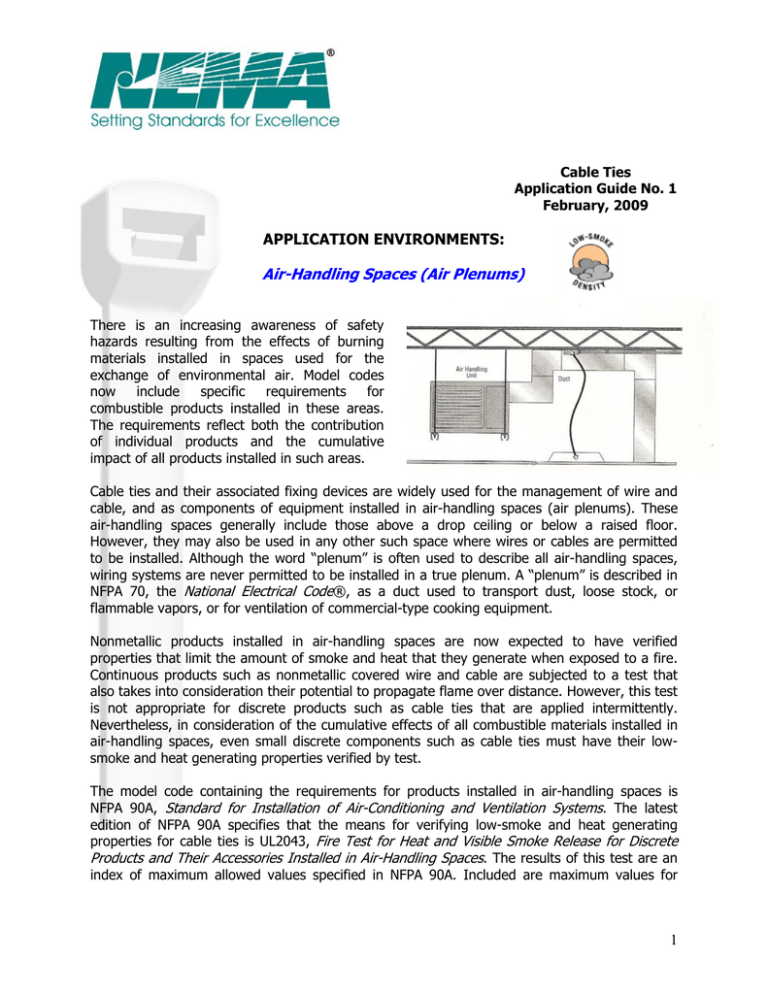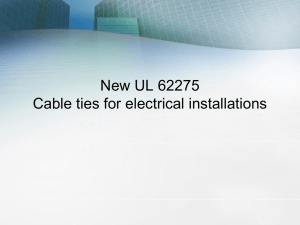CABLE TIES
advertisement

Cable Ties Application Guide No. 1 February, 2009 APPLICATION ENVIRONMENTS: Air-Handling Spaces (Air Plenums) There is an increasing awareness of safety hazards resulting from the effects of burning materials installed in spaces used for the exchange of environmental air. Model codes now include specific requirements for combustible products installed in these areas. The requirements reflect both the contribution of individual products and the cumulative impact of all products installed in such areas. Cable ties and their associated fixing devices are widely used for the management of wire and cable, and as components of equipment installed in air-handling spaces (air plenums). These air-handling spaces generally include those above a drop ceiling or below a raised floor. However, they may also be used in any other such space where wires or cables are permitted to be installed. Although the word “plenum” is often used to describe all air-handling spaces, wiring systems are never permitted to be installed in a true plenum. A “plenum” is described in NFPA 70, the National Electrical Code®, as a duct used to transport dust, loose stock, or flammable vapors, or for ventilation of commercial-type cooking equipment. Nonmetallic products installed in air-handling spaces are now expected to have verified properties that limit the amount of smoke and heat that they generate when exposed to a fire. Continuous products such as nonmetallic covered wire and cable are subjected to a test that also takes into consideration their potential to propagate flame over distance. However, this test is not appropriate for discrete products such as cable ties that are applied intermittently. Nevertheless, in consideration of the cumulative effects of all combustible materials installed in air-handling spaces, even small discrete components such as cable ties must have their lowsmoke and heat generating properties verified by test. The model code containing the requirements for products installed in air-handling spaces is NFPA 90A, Standard for Installation of Air-Conditioning and Ventilation Systems. The latest edition of NFPA 90A specifies that the means for verifying low-smoke and heat generating properties for cable ties is UL2043, Fire Test for Heat and Visible Smoke Release for Discrete Products and Their Accessories Installed in Air-Handling Spaces. The results of this test are an index of maximum allowed values specified in NFPA 90A. Included are maximum values for 1 peak rate of heat release, peak normalized optical density of smoke and the average normalized optical density of smoke. A question that is often asked of manufacturers is: “Are red or maroon colored cable ties the only ones that can be used in air-handling spaces?” The simple answer is no. However, prior to the development of the present performance and verification requirements, cable ties molded from specialized materials with known low smoke properties were often specified. These products are readily identifiable by their maroon color. Among inspection authorities this color code identification has become commonplace. Importantly however, the more recent verification requirements and associated markings should not be overlooked, regardless of color. How do you identify a cable tie that is suitable for use in air-handling spaces? Since NFPA 90A only requires verification for combustible cable ties, all metallic cable ties can be assumed to be suitable for use wherever combustible wire and cable are permitted to be installed. In the National Electrical Code®, these areas are described in Section 300.22 (B), (C), and (D). Nonmetallic or composite cable ties, and metallic cable ties with a nonmetallic coating, are required to meet the requirements of UL 2043. Compliance must be verified by a Nationally Recognized Testing Laboratory (NRTL). These products are only suitable for installation in areas as described in Section 300.22 (C) and (D) of the National Electrical Code®. Cable ties and fixing devices that have been verified as suitable for use in air-handling spaces are provided with the following markings as appropriate. Product Type Standard Label Marking Metallic Cable ties and Fixing Devices "Suitable for use in Air Handling Spaces (plenums)" in accordance with Section 300.22 (B), (C), and (D) of the National Electrical Code, and Rules 12-010 (3), (4), and (5), and 12-020 of the Canadian Electrical Code, Part I or an equivalent wording. Non-metallic or Composite Cable ties and Fixing Devices "Suitable for use in Air Handling Spaces (plenums)" in accordance with Section 300.22 (C) and (D) of the National Electrical Code, and Rules 12-010 (3), (4), and (5), and 12-020 of the Canadian Electrical Code, Part I, or an equivalent wording. New Short-form Coding (Proposed) AH-1 AH-2 As the new NFPA 90A requirements become reflected in the standard for cable ties, the markings in the table may be superseded by a simple reference indicating compliance with UL 2043 in conjunction with the certification mark of the testing laboratory. 2 The manufacturer should always be consulted if there is a question about the proper application of a cable tie or associated fixing device. NEMA members provide high value, consistent quality, safe and efficient use for cable ties and their associated fixing devices that meet the expectations of a wide variety of users. Visit us at http://www.nema.org/prod/be/cable-ties/ for current information on our industry and for the names of NEMA member cable tie manufacturers. 3 NOTICE AND DISCLAIMER The information in this publication was considered technically sound by the consensus of persons engaged in the development and approval of the document at the time it was developed. Consensus does not necessarily mean that there is unanimous agreement among every person participating in the development of this document. The National Electrical Manufacturers Association (NEMA) standards and guideline publications, of which the document contained herein is one, are developed through a voluntary consensus standards development process. This process brings together volunteers and/or seeks out the views of persons who have an interest in the topic covered by this publication. While NEMA administers the process and establishes rules to promote fairness in the development of consensus, it does not write the document and it does not independently test, evaluate, or verify the accuracy or completeness of any information or the soundness of any judgments contained in its standards and guideline publications. NEMA disclaims liability for any personal injury, property, or other damages of any nature whatsoever, whether special, indirect, consequential, or compensatory, directly or indirectly resulting from the publication, use of, application, or reliance on this document. NEMA disclaims and makes no guaranty or warranty, expressed or implied, as to the accuracy or completeness of any information published herein, and disclaims and makes no warranty that the information in this document will fulfill any of your particular purposes or needs. NEMA does not undertake to guarantee the performance of any individual manufacturer or seller’s products or services by virtue of this standard or guide. In publishing and making this document available, NEMA is not undertaking to render professional or other services for or on behalf of any person or entity, nor is NEMA undertaking to perform any duty owed by any person or entity to someone else. Anyone using this document should rely on his or her own independent judgment or, as appropriate, seek the advice of a competent professional in determining the exercise of reasonable care in any given circumstances. Information and other standards on the topic covered by this publication may be available from other sources, which the user may wish to consult for additional views or information not covered by this publication. NEMA has no power, nor does it undertake to police or enforce compliance with the contents of this document. NEMA does not certify, test, or inspect products, designs, or installations for safety or health purposes. Any certification or other statement of compliance with any health or safetyrelated information in this document shall not be attributable to NEMA and is solely the responsibility of the certifier or maker of the statement. 4


